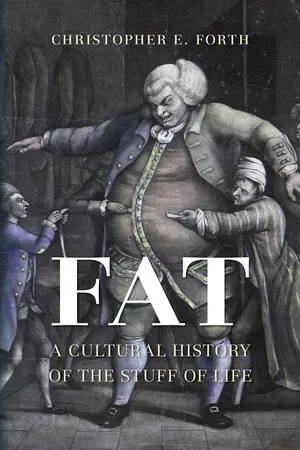![]()
REFERENCES
All translations are the author’s own unless otherwise stated.
Introduction
1 Acknowledging that ‘fat’, ‘fatness’ and ‘corpulence’ are imperfect solutions to the problem of stigmatizing and pathologizing terms like ‘obesity’, I nevertheless follow the usage of scholars like R. Longhurst, ‘Fat Bodies: Developing Geographical Research Agendas’, Progress in Human Geography, XXIX/3 (2005), pp. 247–59; L. F. Monaghan, Men and the War on Obesity: A Sociological Study (London, 2008); and A. C. Saguy, What’s Wrong with Fat? (New York, 2013), p. 7. My occasional use of ‘overweight’ is meant to convey the impressions of various periods. When it appears, ‘obesity’ reflects the terms of original or translated source material.
2 For example, see J. L. Fikkan and E. D. Rothblum, ‘Is Fat a Feminist Issue? Exploring the Gendered Nature of Weight Bias’, Sex Roles, LXVI (2012), pp. 575–92; L. Berlant, ‘Slow Death (Sovereignty, Obesity, Lateral Agency)’, Critical Inquiry, XXXIII/4 (2007), pp. 754–80; S. Strings, ‘Obese Black Women as “Social Dead Weight”: Reinventing the “Diseased Black Woman”’, Signs, XLI/1 (2015), pp. 107–30; V. Swami et al., ‘The Attractive Female Body Weight and Female Body Dissatisfaction in 26 Countries across 10 World Regions: Results of the International Body Project I’, Personality and Social Psychology Bulletin, XXXVI/3 (2010), pp. 309–25.
3 L. Fraser, ‘The Inner Corset: A Brief History of Fat in the United States’, in The Fat Studies Reader, ed. E. Rothblum and S. Solovay (New York, 2009), pp. 11–14; P. Rogers, ‘Fat Is a Fictional Issue: The Novel and the Rise of Weight-Watching’, in Historicizing Fat in Anglo-American Culture, ed. E. Levy-Navarro (Columbus, OH, 2010), pp. 19–39.
4 E. Levy-Navarro, The Culture of Obesity in Early and Late Modernity (Basingstoke, 2008), p. 37.
5 G. Eknoyan, ‘A History of Obesity, or How What Was Good Became Ugly and Then Bad’, Advances in Chronic Kidney Disease, XIII/4 (2006), pp. 421–7. For a recent popular iteration of this narrative, see S. Tara, The Secret Life of Fat (New York, 2017).
6 M. Douglas, Purity and Danger: An Analysis of the Concepts of Pollution and Taboo (New York, 1966). See also Kristeva’s concept of ‘abjection’, a well-known extension of Douglas’s model. J. Kristeva, Powers of Horror, trans. L. S. Oudiez (New York, 1982). For a critique of these related accounts of ‘impurity’, see R. Duschinsky, ‘Abjection and Self-identity: Towards a Revised Account of Purity and Impurity’, Sociological Review, LXI/4 (2013), pp. 709–27; and ‘Ideal and Unsullied: Purity, Subjectivity and Social Power’, Subjectivity, IV/2 (2011), pp. 147–67.
7 J. E. Braziel and K. LeBesco, eds, Bodies Out of Bounds: Fatness and Transgression (Berkeley, CA, 2001).
8 See M. Warin, ‘Material Feminism, Obesity Science and the Limits of Discursive Critique’, Body and Society, XXI/4 (2015), p. 61.
9 On the importance of conceptual frames, see Saguy, What’s Wrong with Fat?
10 O.J.T. Harris and J. Robb, ‘Multiple Ontologies of the Problem of the Body in History’, American Anthropologist, CXIV/4 (2012), pp. 668–79.
11 In one of the most important theoretical discussions of fat embodiment, Samantha Murray reminds us that ‘perception is a mode of bodily being-in-the-world that is constitutive of this being, and is not (and can never be) confined to the “visual”’. S. Murray, The ‘Fat’ Female Body (Basingstoke, 2008), p. 149.
12 M. M. Lelwica, Shameful Bodies: Religion and the Culture of Physical Improvement (London, 2017), p. 46. The ‘visceral’ may be defined in terms of ‘the sensations, moods and ways of being that emerge from our sensory engagement with the material and discursive environments in which we live’. R. Longhurst, L. Johnston and E. Ho, ‘A Visceral Approach: Cooking “at Home” with Migrant Women in Hamilton, New Zealand’, Transactions of the Institute of British Geographers, XXXIV/3 (2009), p. 334.
13 A. E. Farrell, Fat Shame: Stigma and the Fat Body in American Culture (New York, 2011), pp. 127–30.
14 J. C. Oates, Middle Age: A Romance (New York, 2001), pp. 350–51.
15 S. Lawler, ‘Disgusted Subjects: The Making of Middle-class Identities’, The Sociological Review, LIII/3 (2005), p. 442.
16 R. M. Puhl and C. A. Heuer, ‘The Stigma of Obesity: A Review and Update’, Obesity, XVII/5 (2009), pp. 941–64.
17 P. Campos, The Obesity Myth: Why America’s Obsession with Weight Is Hazardous to Your Health (New York, 2004), p. xxiv; see also p. 67. On the role of emotion in responses to fatness, see also A. Phillipson, ‘Re-reading “Lipoliteracy”: Putting Emotions to Work in Fat Studies Scholarship’, Fat Studies, II/1 (2013), pp. 70–86.
18 C. S. Crandall, A. Nierman and M. Hebl, ‘Anti-fat Prejudice’, in Handbook of Prejudice, Stereotyping, and Discrimination, ed. T. D. Nelson (New York, 2009), pp. 469–87; C. S. Crandall, ‘Prejudice against Fat People: Ideology and Self-interest’, Journal of Personality and Social Psychology, LXVI/5 (1994), pp. 882–94.
19 M. Nussbaum, Hiding from Humanity: Disgust, Shame, and the Law (Princeton, NJ, 2004), p. 92. See also C. E. Forth, ‘Fat and Disgust; or, The Problem of “Life in the Wrong Place”’, in Le Dégoût: Histoire, langage, politique et esthétique d’une émotion plurielle, ed. M. Delville, A. Norris and V. von Hoffmann (Liège, 2015), pp. 41–60. When certain ‘visual sensations’ seem to provoke disgust,...
